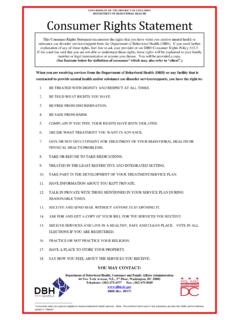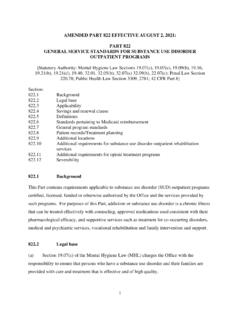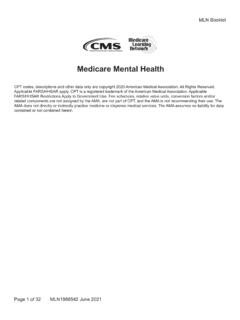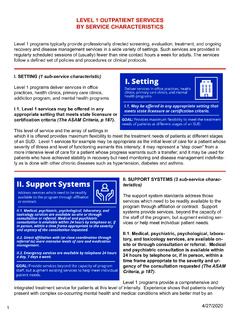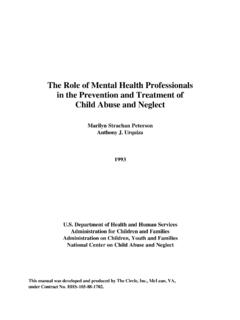Transcription of The Child & Adolescent Level of Care Utilization System ...
1 The Child & Adolescent Level of Care Utilization System (CALOCUS) District of Columbia Department of Mental Health Implementation and Practical Application Training agenda CALOCUS overview Scoring the CALOCUS Uses of the CALOCUS Case vignettes Completing CALOCUS on the WebATThe CALOCUSWhat is it and why use it? ATWhat is the CALOCUS? C - Child & A - Adolescent L Level O of C Care U Utilization S System An assessment and placementInstrument developed by American Association of Community Psychiatrists (AACP) American Academy of Child & Adolescent Psychiatry (AACAP)Also called the Child andAdolescent Service IntensityInstrument (CASII) ATWhy use the CALOCUS? Combines assessment (clinical needs) with levels of care (resource management) Measure psychiatric, addiction and developmental disorders individually or as overlapping clinical disorders Ease of use, time effective, adaptability Reliable and valid results and recommendationsAT Quantifiable, facilitating communication, interactiveness, consistency and tracking change Designed to be used across systems and agencies by a variety of Child - serving professionals Not dependent on diagnoses Intended for use in teams Why use the CALOCUS?
2 ATFundamental principles Creates common framework for decision making on Level of care placement, continued stay, & outcomes Based on Adult LOCUS, but reflects developmental perspective and family focus Appropriate for use with ages 6 through18 No cutoff age for using adult vs. C&A version (use the most appropriate depending on developmental Level ) Applies to mental illness, substance use, and developmental disordersATCALOCUS Assessment Dimensions Determine the intensity of service needs Provide a spectrum along which a client may lie on each of the dimensions Quantifiable to convey information easily Composite Score based on 5-point scale Shows interaction of individual dimensions Creates moving picture of client over timeATSix assessment dimensions1. Risk of Harm2. Functional Status3. Co-Morbidity4. Recovery Environment (stress + support)5. Resiliency and treatment History6. Acceptance and Engagement (Scale A - C&A, Scale B - Parent/Caretaker)ATCALOCUS levels of care Define resources in flexible/adaptable terms Applicable to wide variety of service environments and systems Each Level made up of 5 main ingredients: care environment; clinical services; support services; crisis stabilization; and prevention servicesATSix service levels of care Basic Services (not a service Level of care)LEVELS: I.
3 Recovery Maintenance and Health ManagementII. Outpatient ServicesIII. intensive Outpatient ServicesIV. intensive Integrated Service w/o 24 Hr. Psychiatric MonitoringV. Non-Secure, 24 Hr., Services w/ Psychiatric MonitoringVI. Secure, 24 Hr., Services w/ Psychiatric MonitoringLOWHIGHLOWHIGHATS coring the CALOCUSP rocedures and considerations for determining appropriate levels of care ATDimensional rating System *Resource: Dimensions of CALOCUS Assesses Level of severity of client s needs Each dimension has a 5-point rating scale Each point has one or more criteria Only 1 criteria needs to be met for the rating to be assigned If there is criteria in two points pick the highest Do not add criteria to get a higher scoreAT Ratings range from minimal (0) to extreme (5) If nothing fits exactly, pick the closest fit err on the side of caution Use interview, clinical judgment, records, family, school, and collaborative data *Resource.
4 CALOCUS interview protocolDimensional rating systemATDimensional rating System Presenting problem is the primary problem (base this on how the Child , youth and family define the primary problem) Other problems may be co-morbid conditions Does the condition exacerbate or have the potential to prolong the course of treatment ? Evaluate client as he/she appears in the present Exception: If a client is in a residential placement rate Recovery Environment ( Level of Stress & Level of Support), according to their home environment. ATScoring the CALOCUS Scoring: The composite score: 6 dimensions, 7 scores Highest possible score for each dimension= 5*Scoring Resources: 1) Decision Grid; 2) Decision Tree and 3)CALOCUS Web-based Application ATSix assessment Risk of Harm2. Functional Status3. Co-Morbidity4. Recovery Environment Level of Stress Level of Support5. Resiliency and treatment History6. Acceptance and Engagement(Scale A - C&A, Scale B - Parents/CaretakerATRisk of harm Potential to be harmed by others or cause significant harm to self or others Frequently manifested by suicidal/homicidal behaviors/thoughts May embody unintentional harm from distorted reality, inability to care for self, impaired judgement, or intoxication Assess Level of distress (significant/extreme?
5 Differentiate between chronic or acuteATRisk of includes? Suicidal or homicidal thought or impulses Physical or sexually aggressive impulses Victimization, abuse or neglect Substance use/abuse Other considerations: history, ability to contract for safety and use supports ATFunctional status 4 Factors considered: Ability to fulfill responsibilities Ability to interact with others Vegetative status (ADL s, activity Level , etc.) Ability to care for themselves Compare to baseline or expected Level Base rating on recent changes (chronic vs. acute)AT Measures coexistence of disorders across 4 domains (developmental, medical, substance abuse, psychiatric) Identify presenting condition (most readily apparent issue) Conditions identified later are co-morbid Physiological withdrawal is medical co-morbidity Co-morbid issues may prolong illness, and necessitate more intensive /additional servicesCo-morbidityATCo-morbidityFor the purposes of the CALOCUS, ifchild has more than one disorder in thesame domain, the secondary is not counted as a comorbid condition.
6 Examples: Psych with Dev. SA, Med. SA with Psych, Dev. environment Acknowledges that children and adolescents are dependent on, and have less control, over their environment than adults Recovery environment includes: home, school, medical, social services, juvenile justice, etc., where involvement is on-going Divided into 2 sub-scales: Environmental Stress Environmental SupportATRecovery environment Considers factors in the environment that contribute to the primary disorder and factors that support efforts for recovery. Base rating on what the client would experience in home or un-protected environmentATRecovery environment: Stressful elements Interpersonal conflicts Trauma Life transitions Losses Worries related to health / safety Difficulty maintaining role responsibilitiesATRecovery environment: Supportive elements Stable, supportive relationships w/ family Adequate housing Adequate material resources Stable, supportive relationships w/ friends, employers, teachers, clergy, professionals, and other community membersATResiliency & treatment history Resiliency refers to capacity for successful adaptation, use of internal and external resources Assessed based on Child s response to past treatment , life stressors and changes Recognizes that history of responses to TX provide some indication of how he/she is likely to respond in the futureATResiliency & treatment history Place more weight on recent experiences than those occurring in the past Recovery defined as maintenance of period of stability but.
7 Also as a resumption of progress to expected developmental levelATAcceptance and engagement Measures both Child / Adolescent and primary care taker s acceptance and engagement in treatment Divided into 2 sub-scales to reflect the importance of primary care taker s willingness and ability to participate in treatment If Child / Adolescent is emancipated, care taker s sub- scale is not scored Only the highest of the 2 sub-scale scores is added into the composite score ATAcceptance & engagement: Child / Adolescent subscaleMeasures Child / Adolescent s ability to: Form a positive therapeutic relationship Define the presenting problem Accept responsibility for presenting problem Accept role in the treatment process Actively cooperate in treatmentATMeasures caretaker s ability to: Form a positive therapeutic relationship Engage w/ Clinician in defining presenting problem Explore their role as it impacts the problem Take an active role in the treatment planning and processAcceptance & engagement: caretaker subscaleATDetermining Level of care recommendation1.
8 Compute severity ratings on each of the 6 dimensions2. Compute composite score based on 7 scores from 6 dimensions3. LOCUS software automatically computes the composite score and Level of care recommendation*The Level of Care Determination Decision Tree and Level of Care Determination Grid can also be used to determine Level of care recommendationATTrump ratings I. Risk of Harm If Dimension Score = 4, then Level of Care = 5 If Dimension Score = 5, then Level of Care = 6II. Functional Status If Dimension Score = 4, then Level of Care = 5 If Dimension Score = 5, then Level of Care = 6 (only exception when IVA & IVB = 2, indicating minimally stressful and highly supportive recovery environment) III. Comorbidity If Dimension Score = 4, then Level of Care = 5 (only exception when IVA & IVB = 2, indicating minimally stressful and highly supportive recovery environment) If Dimension Score = 5, then Level of Care = 6 ATHelpful Hints / Reminders Collect complete data Acute problems score: 3, 4, or 5 Chronic problems score: 3, 2, or 1 DO NOT load stress on all dimensions If you can t decide between 2 scores choose the higher oneATQuestions?
9 Break Time Please return in 10 minutes ATLevel of Care Services Defines services by levels of resource intensity 7 levels of care / 6 are service levels Services are defined by 4 variables: Clinical Services (CS) Support Services (SS) Crisis Stabilization and Prevention Services (CS/PS) Care Environment (CE)ATLevels of Care Basic Services (not a service Level of care) Recovery Maintenance & Health Management Outpatient Services intensive Outpatient Services intensive Integrated Service w/o 24 Hr. Psychiatric Monitoring Non- Secure 24 Hr. Services w/ Psychiatric Monitoring Secure 24 Hr. Services w/ Psychiatric ManagementResource: Level of Care CrosswalkATLevel 0: Basic Services Prevents onset of illness Limits the magnitude of morbidity associated with problems in various stages of improvement or remission Developed for individual or community application Variety of community settings Available to all members of communityATLevel 0: Basic Services CE: easy access, convenient location, various community settings, home CS: mental health screenings; 24hr.
10 Availability for evaluations., brief interventions, & linkage to services SS: crisis stabilization and ability to mobilize resources; collaboration with community groups CS/PS: 24/7 crisis services available and publicized, includes outreach to vulnerable populations ATLevel I: Recovery Maintenance and Health Management Provides follow-up care to mobilize family strengths & reinforce links w/ natural supports Clients are substantially recovered & issues sufficiently manageable within the family Problems no longer threatening to expected growth and developmentATLevel I: Recovery Maintenance and Health Management CE: traditional mental health setting, ease of access, adequate design, w/ specific service needs, safe and comfortable CS: readily accessible to avert need for higher Level of care, limited interventions, case mgmt., follow up medications SS: natural supports, families w/ capacity to access resources w/o professional help CS/PS: 24hr.

